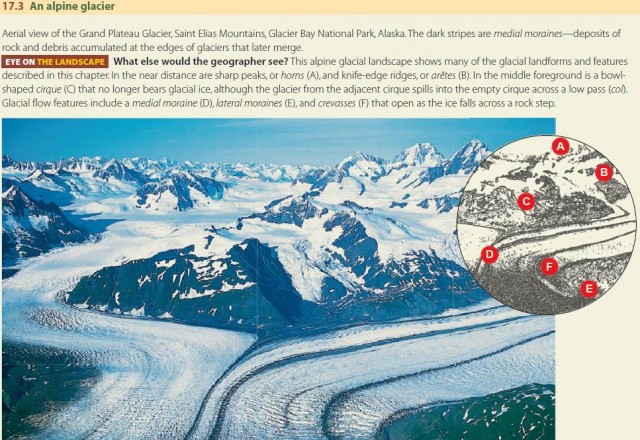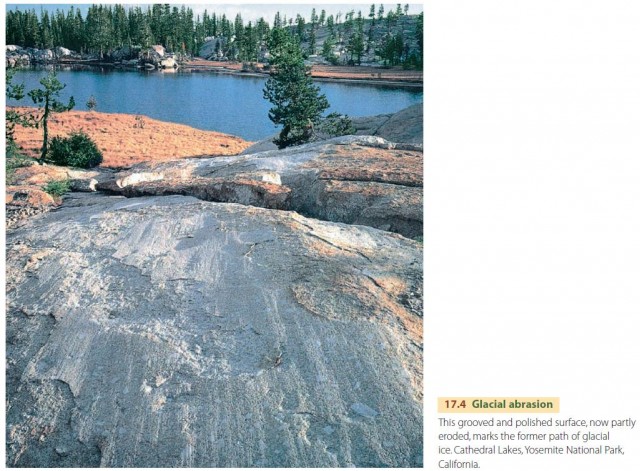Glaciers
Not long ago, during the Ice Age, much of northern North America and Eurasia was covered by massive sheets of glacial ice. As a result, glacial ice has shaped large landforms in midlatitude and subarctic zones. Today, we find glacial ice in the Greenland and Antarctic Ice Sheets and in many smaller masses in high mountains.
Glacial ice sheets have a significant impact on our global climate. Because of their intense whiteness, the glacial ice sheets of Greenland and Antarctica reflect much of the solar radiation they receive, influencing the Earth's radiation and heat balance. The vast temperature difference between these intensely cold ice sheets and regions near the Equator helps drive the system of heat transport around the world.
These collections of ice also hold an enormous amount of water in solid state. When the volume of glacial ice increases, as it does during an ice age, sea levels must fall to maintain the global water balance. When ice sheets melt away, sea level rises. In fact, today's coastal environments evolved during a rising sea level accompanying the melting of the last ice sheets of the Ice Age.
GLACIER FORMATION
When we think of ice, we normally picture a brittle, crystalline solid. But large bodies of ice, with a great thickness, are much more plastic. That's because the pressure on the ice at the bottom of an ice mass forces it to lose its rigidity. A thick mass of ice can flow in response to gravity, slowly spreading out over a larger area or moving downhill. Ice also slides on steep mountain slopes. This ability to move is the key characteristic of a glacier, which is defined as any large natural accumulation of land ice affected by present or past motion.
Glacial ice builds up when the average snowfall of the winter exceeds the amount of snow that is lost in summer by evaporation and melting. Each year, a new layer of snow adds to the snow that has already collected. Snow on the surface melts and refreezes, compacting the snow and turning it into granular ice. This ice is then compressed into hard crystalline ice by the weight of the layers above it. When the ice mass becomes so thick that the lower layers become plastic, it will start to flow outward or downhill. The ice mass is now an active glacier (Figure 17.3).

Glacial ice forms in regions where there are low temperatures and high amounts of snowfall. This can occur at both high elevations and high latitudes. In mountains, glacial ice can form even in tropical and equatorial zones if the elevation is high enough to keep average annual temperatures below freezing. In high mountains, glaciers flow from small high-elevation collecting grounds down to lower elevations, where temperatures are warmer. Here the ice disappears as it melts and evaporates. Typically, mountain glaciers are long and narrow because they occupy former stream valleys. These alpine glaciers are a distinctive type of glacier that we will look at in the next section.
In arctic and polar regions, temperatures are low enough for snow to collect over broad areas, eventually forming a vast layer of glacial ice. Snow begins to accumulate on uplands, which are eventually buried under enormous volumes of ice. The layers of ice can reach a thickness of several thousand meters. The ice then spreads outward, over surrounding lowlands, and covers all landforms it encounters. We call this extensive type of ice mass an ice sheet.
GLACIAL EROSION AND DEPOSITION
Glacial ice normally contains rock that it has picked up along the way. These rock fragments range from huge angular boulders to pulverized rock flour. Most of this material is loose rock debris and sediments found on the landscape as the ice overrides it, but some is eroded from the rock floor on which the ice moves. Alpine glaciers also carry rock debris that slides or falls from valley walls onto the surface of the ice.
Glaciers and ice sheets erode and deposit great quantities of sediment. The rock fragments held within the ice scrape and grind against bedrock (Figure 17.4). We call this erosion process glacial abrasion. Moving ice also erodes surfaces by plucking, as blocks that have been loosened by weathering are lifted out of bedrock. Abrasion and plucking smooth the glacier bed as the glacial flow continues through time. The glacier finally deposits the rock debris at its lower end, where the ice melts. Both erosion and deposition create distinctive glacial landforms.
